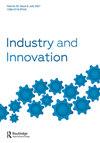与朋友相处:通过人工智能和区块链加强多竞争对手的合作治理
IF 4.2
3区 管理学
Q1 ECONOMICS
引用次数: 2
摘要
本文章由计算机程序翻译,如有差异,请以英文原文为准。
Getting along with frenemies: enhancing multi-competitor coopetition governance through artificial intelligence and blockchain
ABSTRACT Collaborating with one competitor is difficult but collaborating with several competitors is a monumental challenge. However, multi-competitor coopetition, or cooperation between multiple competitors, is increasing. This study examines how recent advancements in artificial intelligence (AI) and blockchain can support multi-competitor coopetition by enhancing governance. Examining two coopetitive R&D consortia in pharmaceuticals and medical imaging, we find that a nascent form of AI called federated learning can address key coopetition concerns such proprietary and confidential data protection, knowledge leakage, data sovereignty and silos thereby maintaining organisational boundaries and autonomy. The use of federated learning and blockchain increases transparency and accountability, which reduces information asymmetries and power differential inequities. Together, these technologies decentralise governance and authority, reducing the tension between collective value creation and individual value appropriation inherent in coopetition, particularly those with multiple competitors. Finally, this study illustrates how emerging technologies challenge traditional assumptions about organisational boundaries, distributed innovation, and coopetition.
求助全文
通过发布文献求助,成功后即可免费获取论文全文。
去求助
来源期刊

Industry and Innovation
Multiple-
CiteScore
8.10
自引率
7.70%
发文量
41
期刊介绍:
Industry and Innovation is an international refereed journal presenting high-quality original scholarship of the dynamics of industries and innovation. Interdisciplinary in nature, Industry and Innovation is informed by, and contributes in turn to, advancing the theoretical frontier within economics, organization theory, and economic geography. Theoretical issues encompass: •What are the institutional underpinnings for different organizational forms? •How are different industrial structures and institutions related to innovation patterns and economic performance?
 求助内容:
求助内容: 应助结果提醒方式:
应助结果提醒方式:


